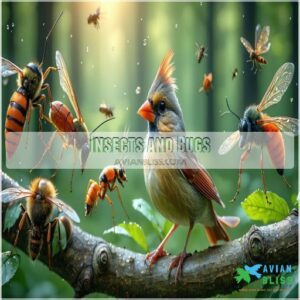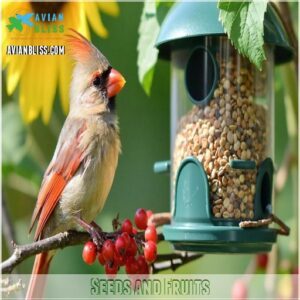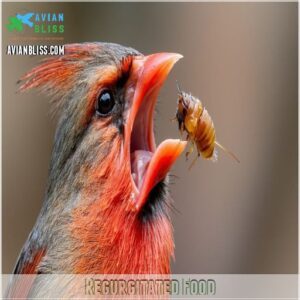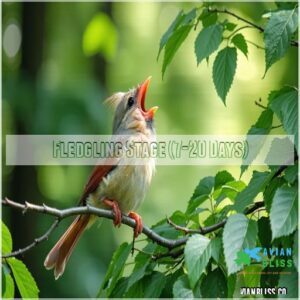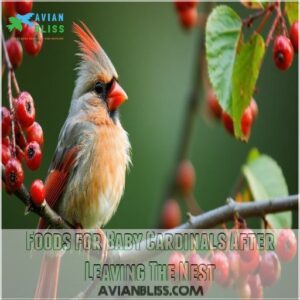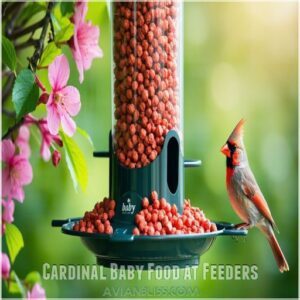This site is supported by our readers. We may earn a commission, at no cost to you, if you purchase through links.

These tiny birds start out feasting on soft-bodied caterpillars, worms, and other insects, which fuel their rapid growth. Baby cardinals get their essential vitamins and minerals from these bugs, with occasional helpings of regurgitated food neatly delivered by doting parents.
As they grow, their diet gradually expands to include sunflower seeds, berries, and fruits, thanks to their ever-busy parents.
Additionally, both male and female cardinals share the feeding duties, with meals arriving every 15 to 30 minutes during daylight.
Curious how they handle it all? Keep reading!
Table Of Contents
- Key Takeaways
- Baby Cardinal Diet Basics
- What Do Baby Cardinals Eat in The Nest
- Cardinal Parent Feeding Habits
- Baby Cardinal Development Stages
- Foods for Baby Cardinals After Leaving The Nest
- Cardinal Baby Food at Feeders
- Baby Cardinal Feeding Behavior
- What to Feed Injured Baby Cardinals
- Tips for Feeding Baby Cardinals
- Baby Cardinal Diet and Health
- Frequently Asked Questions (FAQs)
- What do Baby Cardinals eat?
- What do Cardinal chicks eat?
- Do both parents feed baby Cardinals?
- What do Baby Cardinals rely on their parents for?
- What can you feed a cardinal?
- Do Cardinals eat soft food?
- Why do male cardinals feed female cardinals?
- What is the cardinals’ most favorite food?
- How much do cardinals eat every day?
- What are the differences in diet between northern and southern cardinals?
- Conclusion
Key Takeaways
- You’ll find that baby cardinals start with a diet rich in protein from insects like caterpillars and worms, which is essential for their growth.
- As they grow, their diet expands to include seeds and fruits, with sunflower seeds and berries being favorites.
- Both parents are involved in feeding, delivering food every 15 to 30 minutes during daylight, ensuring the chicks are well-nourished.
- To support young cardinals, offer appropriate foods at feeders and ensure a safe environment away from predators.
Baby Cardinal Diet Basics
You’ll find that baby cardinals need a diet rich in high-protein insects for strong growth, especially in their early days.
As they mature, seeds and fruits become increasingly important, supplementing their insect-based meals.
Primary Food Sources
Baby cardinals aren’t too picky, but they do have gourmet tastes regarding insects and bugs.
Think of it as a tiny buffet of delights: soft-bodied caterpillars, a variety of insects, and tender worms.
Their diet is primarily composed of protein-packed insects and fruits which are rich in essential nutrients.
These insect-rich meals are served with a touch of parental care—regurgitated treats.
Their dining preferences expand as they grow, branching into seeds later.
Nutritional Needs
A young cardinal’s growth springs from a diet abundant in protein and calcium, much like the fuel propelling a train down its tracks.
No cereal here—it’s all about avoiding those vitamin gaps.
Think of these choices as the secret sauce for growing wings and singing tunes.
Here’s their grocery list:
- Protein-packed insects
- Nutritious berries
- Calcium-rich snacks
- Healthy supplements
Feeding Frequency
Imagine the bustling life of feeding baby cardinals!
Those tiny beaks demand food every 15 to 30 minutes during daylight.
Think of it as their own little food fest.
Key factors to keep in mind:
- Age-based variations
- Parental roles in feeding
- Best time of day
- Nestling size matters
This phase is a whirlwind of cardinal care!
What Do Baby Cardinals Eat in The Nest
In the nest, baby cardinals rely heavily on protein-rich insects that are initially regurgitated by their parents.
These little chicks also eat small amounts of seeds and fruits, providing a balanced diet essential for their rapid growth and development.
Insects and Bugs
Cardinal chicks have high bug preferences, relying on insects for essential growth nutrients.
Cardinal parents are expert bug hunters, providing a varied diet of bugs like caterpillars and beetles. This insect diversity is essential for development.
If you’re interested in supplementing their natural diet, consider purchasing from a trusted Cardinal Bug Feed. Here’s what to keep in mind:
- Bugs are protein-packed.
- Diversity supports health.
- Parents excel at bug collection.
- Bug nutrition is essential for growth.
Seeds and Fruits
There’s nothing like a fresh burst of sunshine to get your day started, and for cardinal chicks, sunflower seeds and berries offer that very spark.
They munch on these nutrient-rich treats to fuel their rapid growth.
Here’s a handy table to showcase the cardinal fruit preferences and seed types ideal for nestlings during various seasons:
| Nutrient | Source |
|---|---|
| Protein | Sunflower seeds |
| Vitamins | Berries |
| Fats | Pumpkin seeds |
| Carbohydrates | Small fruits (e.g., grapes) |
Keeping these favorites well-stocked will help your backyard birds thrive.
Regurgitated Food
Baby cardinals rely on regurgitated food, a key part of their early diet.
Parents partially digest food, making it easier for their young to process, typically feeding them soft invertebrates for easy digestion.
This nutritious "baby bird food" is rich in protein and other nutrients essential for chick development.
Both parents share this feeding responsibility, a beautiful example of parental care.
Cleanliness is important to prevent illness in these tiny nestlings.
Cardinal Parent Feeding Habits
Among cardinals, both parents share the responsibility of feeding their young, ensuring a steady supply of nutritious food.
Both parents work together to care for their young.
The male cardinal steps up by providing insects and seeds, while the female focuses on keeping the nest comfortable and secure.
Male Cardinal’s Role
Imagine the male cardinal as a dedicated bird dad, feeding chicks with spiders and insects while keeping a sharp eye on potential threats.
His red feathers might fade a bit, but not his dedication to nest building and territory protection.
This diligent fellow makes sure the cardinal chicks get the best start in life, juggling nest duties and feeding swift, hungry mouths.
Female Cardinal’s Role
The female cardinal shines as a devoted parent.
She skillfully handles nest building and egg incubation, ensuring her cardinal chicks get the best start.
For those interested in supporting their cardinal parenting journey, a cardinal feeding guide provides valuable insights.
During chick feeding, she expertly joins forces with her mate, providing a steady diet of insects and seeds.
Her role in parental care is vital, nurturing baby cardinals into healthy adults with her attentive presence.
Cooperative Breeding
Cardinals are teamwork experts in raising their young.
Both parents share the feeding chores, ensuring the little ones thrive.
The male often hunts for insects, while the female handles brood balance and sibling squabbles, typically within the safety of their 5-10 feet off the ground nesting locations.
Watch them in action:
- Vibrant red males fetch insects.
- Resourceful females manage family dynamics.
- Food-sharing rituals keep nestlings well-fed and healthy.
Baby Cardinal Development Stages
In observing baby cardinal development, you’ll notice distinct stages starting with fledglings from 7 to 20 days as they grow rapidly.
By the juvenile stage at 20 days old, these young birds begin to resemble adults in size, though their plumage remains a muted brown.
Fledgling Stage (7-20 Days)
At the fledgling stage, baby cardinals, aged 7-20 days, start exploring beyond the nest, their wings itching to take flight.
As they practice flutter-hopping, both parents remain devoted, providing a cardinal chick diet of insects, seeds, and regurgitated food.
This teamwork helps fledgling growth, preparing them for nest departure.
Though they appear vulnerable to predators, these young birds are well-guided by their parents.
Gradually, fledglings develop flight skills, moving their bird nestling food intake to what supports their newfound independence.
Juvenile Stage (20+ Days)
Their juvenile plumage, a mix of brown and subtle red, marks a new chapter.
Fledgling independence begins as they learn to forage, guided by parents. This stage focuses on developing their hunting skills and learning to avoid predators.
Growth slows, but they’re still learning. Social behavior involves interactions with siblings and parents.
Dietary shift involves eating more seeds and less insects. Baby cardinal food now includes a wider variety of items. This is a vital stage for their survival.
Foods for Baby Cardinals After Leaving The Nest
Once baby cardinals leave the nest, you’ll find they gradually shift from an insect-heavy diet to include more seeds and soft fruits.
Offering live mealworms and suet can help provide the protein they need, supporting their rapid growth and energy demands.
Live Mealworms
Ever thought about how mealworms could be the perfect treat for baby cardinals just out of the nest?
These little wrigglers are a powerhouse of protein and moisture, boosting growth while quenching their thirst.
Keep them cool in vented containers for freshness.
Missing mealworms? No worries—try soaked dried mealworms, chopped crickets, or even some juicy fruits.
Suet and Seeds
When you’re nourishing those baby cardinals who’ve just left their nest, suet and seeds are your trusty allies. Suet acts like a power snack – think energy bar, but for birds. And seeds? They’re the multivitamins of the avian world.
- Suet benefits: High energy
- Suet recipes: DIY options abound
- Seed types: Sunflower, safflower
- Seed storage: Fresh and dry
- Suet vs. seeds: Balanced diet essentials
Fresh Fruits
Once fledglings leave the nest, tasty fruits become a key part of their diet.
Explore fruit types, ensuring they’re ripe and safe for those tiny beaks.
Seasonal fruits, like apples and berries, add variety.
These juicy treats make cardinal chicks chirp with delight, while adding a splash of color to their meals.
- Juicy berries excite.
- Apples for variety.
- Grapes bring joy.
Cardinal Baby Food at Feeders
When setting up feeders for baby cardinals, it’s important to choose the right type to match their dietary needs.
Tube, tray/platform, and squirrel-proof feeders each offer distinct advantages, ensuring young cardinals get a balanced diet.
Tube Feeders
So, you’re helping baby cardinals? Tube feeders aren’t ideal. Cardinals prefer broader perches. They need room to eat comfortably.
When feeding baby birds, you should keep in mind determining baby bird’s feeding needs.
Here’s what you should know:
- Choose tube feeders with wide perches.
- Consider adding a tray below.
- Offer high-quality sunflower seeds.
- Clean frequently to prevent disease.
- Place feeders strategically, away from predators.
Tray/Platform Feeders
Imagine setting up a buffet for baby cardinals with tray or platform feeders.
These feeders offer comfort and space for their broader build, making them a top choice for feeding baby birds.
Place them near cover for safety, and keep them clean—just like tidying up after dinner—to avoid spreading diseases.
It’s about comfort, variety, and cleanliness in feeding.
Squirrel-Proof Feeders
If you’re looking to keep sneaky squirrels at bay, squirrel-proof feeders are your best bet.
These clever designs protect cardinal nestling food, like black oil sunflower seeds, from furry intruders.
For DIY enthusiasts, try creating your own squirrel-proof options at home.
Just remember, placement is key—keep feeders away from trees so squirrels can’t leap like Olympians.
Baby Cardinal Feeding Behavior
You can observe young cardinals begging for food with high-pitched calls and flapping wings, a behavior essential for attracting parental attention.
Fledglings begin foraging and learning important survival skills through social interactions with their family as they develop.
Begging for Food
Observing baby cardinals’ begging behavior is quite a spectacle.
Their animated "feed me" dances, accompanied by baby cardinal calls, stir parental instincts, ensuring prompt food delivery.
Sibling competition adds to the drama, as each nestling vies for attention.
This lively scene keeps the cardinals well-fed and showcases their unique social dynamics, important for understanding cardinal nestling diet nuances.
Foraging for Food
Ever wonder how baby cardinals master foraging?
It’s an adventure guided by their parents, who teach nestlings where to find the best bird feeders for cardinals.
Through food source competition and seasonal diet changes, fledglings learn essential skills.
With practice, they navigate the realm of insects and seeds, proving that in nature, trial and error is the best teacher!
Social Learning
As baby cardinals grow, they rely on social learning—watching parents for cues and mimicking their foraging habits.
Nestmate interactions help them grasp food choices, with parental influence and sibling rivalry adding flavor to their learning.
These little birds master survival through imitation, becoming savvy in vocalization patterns and resourceful in bird feeding tactics.
What to Feed Injured Baby Cardinals
Finding the right food for an injured baby cardinal is important for its survival.
You can offer high-protein options like soaked dry pet food mixed with soft fruits, or even wet cat food (tuna or salmon works well), but always avoid dairy products.
Nutrition-Rich Foods
If you’re looking to feed injured baby cardinals, ensuring their recovery requires the right nutrition.
Protein-rich foods like moistened cat or dog food can work wonders.
You’ve got to think about the essentials:
- High-protein content to aid growth
- Small berries for variety and nutrients
- Frequent feeding schedule every 30 minutes
This diet supports their healing without any extra water needed.
Easy-to-Digest Foods
Looking after injured baby cardinals doesn’t have to feel like solving a puzzle.
You’ll need soft, digestible foods like cooked egg yolk or moistened dog or cat food.
These choices support baby bird digestion, offering smooth sailing on their road to recovery.
Giving these feathered friends a comfy, nutritious meal helps them heal faster.
| Food Option | Why It Works | Preparation Tip |
|---|---|---|
| Cooked Egg Yolk | High protein | Boil 10 minutes |
| Wet Dog Food | Nutrient-rich | Make sure it’s moistened |
| Wet Cat Food | Gentle digestion | Use a damp spoon |
| Insect Puree | Natural diet | Blend with water |
| Soaked Birdseed | Soft texture | Overnight water soak |
Avoiding Human Food
Sure, sharing your lunch might seem kindly, but beware—human food dangers lurk for injured baby cardinals.
Opt for bird-friendly snacks like mealworms or small fruit bits instead.
These safe alternatives meet nutritional needs without the risk of cardinal toxicity.
Keep them chirping heartily by avoiding feeding mistakes with inappropriate foods.
Remember, a healthy diet equals happy tunes!
Tips for Feeding Baby Cardinals
When feeding baby cardinals, keep fresh water available to make sure they stay hydrated, especially during warm weather.
Clean feeders regularly to prevent the growth of mold and bacteria.
Place them in safe areas to keep predators at bay.
Fresh Water Availability
Let’s explore the importance of fresh water for baby cardinals.
Providing the right water sources guarantees their well-being.
Opt for rainwater or fresh tap, and keep a keen eye on water quality to prevent dehydration.
Consider using a cardinal water feeder (Cardinal Water Feeder Options) to make hydration more accessible for the birds.
Make sure water access is easy by placing it within reach, so those tiny birds can stay happily hydrated.
Keep it fresh, stay bird-smart!
Clean Feeders
Keeping those feeders spick and span is your secret weapon against disease.
A regular cleaning schedule is key—get scrubbing every couple of weeks, especially when it’s wet out.
Use safe materials like a mild water-to-bleach mix for feeder hygiene.
Think of it as giving your baby cardinal’s dining room a fresh makeover, ensuring a cheerful, mold-free meal spot!
Avoiding Predators
Protecting your baby cardinals from predators is key.
Keep nesting areas away from reflective surfaces; cardinals might attack their reflections!
Avoid using harmful chemicals near nests.
Position feeders away from bushes—predators often hide there.
Safeguarding your little ones takes simple steps.
Baby Cardinal Diet and Health
To keep baby cardinals healthy, focus on a diet rich in protein and calcium to support their rapid growth and bone development.
Avoid the pitfall of malnutrition by ensuring a balanced intake.
Remember, even young birds can be picky like teenagers at dinner!
Protein-Rich Foods
Baby cardinals are picky eaters regarding protein, enjoying a variety of insects like beetles and ants.
Meet their nutritional needs with the best food for baby cardinals by comparing options:
| Protein Source | Benefit |
|---|---|
| Beetles | Packed with protein |
| Soldier Fly Larvae | Nutritional powerhouse |
| Ants | Easy on the tummy |
These foods fuel their growth beautifully!
Calcium-Rich Foods
Just like strong tree trunks, baby cardinals need calcium for sturdy bones.
- Eggshell benefits: Crushed eggshells are a great way to boost calcium.
- Calcium-rich insect types: Mealworms and crickets offer a natural calcium boost.
- Seed-based diets warning: Avoid common pitfalls that lead to low blood calcium levels in birds, which can result in weak bones and poor egg quality, as explained in more details about calcium absorption low blood calcium in birds.
- Supplements: Safe, bird-specific calcium supplements can also help.
Watch for signs of deficiency, like weak bones, to maintain good health.
Avoiding Malnutrition
Ensuring your baby cardinal thrives means playing nutrition detective.
A balanced meal of insects and mealworms supports growth.
Dietary supplements and protein-rich foods prevent malnutrition. Monitor their healthy weight and provide the best food for baby cardinals.
With nutritious care, you’ll keep your little ones happily chirping and not wobbling on tired wings, ensuring a robust baby bird diet. baby cardinal
Frequently Asked Questions (FAQs)
What do Baby Cardinals eat?
Initially, they’re fed regurgitated insects by their parents. As they grow, you’ll see them eating whole insects and eventually seeds and berries. It’s quite a feast for a tiny bird!
What do Cardinal chicks eat?
Did you know cardinals can double their size in just two weeks?
Cardinal chicks feast on a bug buffet of grasshoppers, beetles, and katydids, which their parents regurgitate, providing the protein-packed nutrition they need to grow.
Do both parents feed baby Cardinals?
Yes, both cardinal parents feed their chicks.
The male often steps up his involvement over time, sharing the duty of providing insects and eventually shifting the chicks to seeds as they grow.
Teamwork makes family life!
What do Baby Cardinals rely on their parents for?
Picture a tiny, fluffy bird nestled in a safe nest.
Baby cardinals depend on their parents for warmth, protection, and food.
regurgitated insects essential for their rapid growth and development.
What can you feed a cardinal?
To feed cardinals, offer sunflower seeds, safflower seeds, peanuts, and cracked corn.
They love fruits like apples, grapes, and cherries too.
Supplement with mealworms and suet, especially in winter, for extra energy and nutrients.
Do Cardinals eat soft food?
Cardinals happily munch on soft foods like fruits and insects, especially when feeding their young.
Adult cardinals may offer seeds softened by rain or dew, ensuring they’re easy to eat and packed with energy.
Why do male cardinals feed female cardinals?
Think of it like chivalry among birds—male cardinals feeding females is their way of sharing nutrients during egg incubation.
It guarantees she stays healthy, giving her full energy to nurture the future generation.
What is the cardinals’ most favorite food?
Sunflower seeds are a top choice, but they also gobble up insects, berries, and nuts. It’s a varied menu for these feathered friends! They’re not picky eaters, you see.
How much do cardinals eat every day?
Ever wonder what birds eat daily?
Cardinals typically consume about ½ to ¼ of their body weight in food each day.
Their diet includes seeds, insects, and fruits, ensuring they stay well-fed and energetic.
What are the differences in diet between northern and southern cardinals?
While northern and southern cardinals typically have similar diets.
Regional variations may include specific insect and fruit types available locally.
Both regions enjoy seeds, grains, and fruits, but insects might differ based on local availability.
This is because of regional variations.
Conclusion
Wondering what baby cardinals eat? It’s simpler than you’d think.
They start with insects like caterpillars for protein, then expand to seeds and fruits as they grow.
Both parents pitch in, offering meals every 15 to 30 minutes.
By providing the right foods at feeders and watching out for predators, you can support young cardinals’ healthy development and curious appetites. You might worry about their delicate needs, but these little ones thrive on nature’s bounty.


